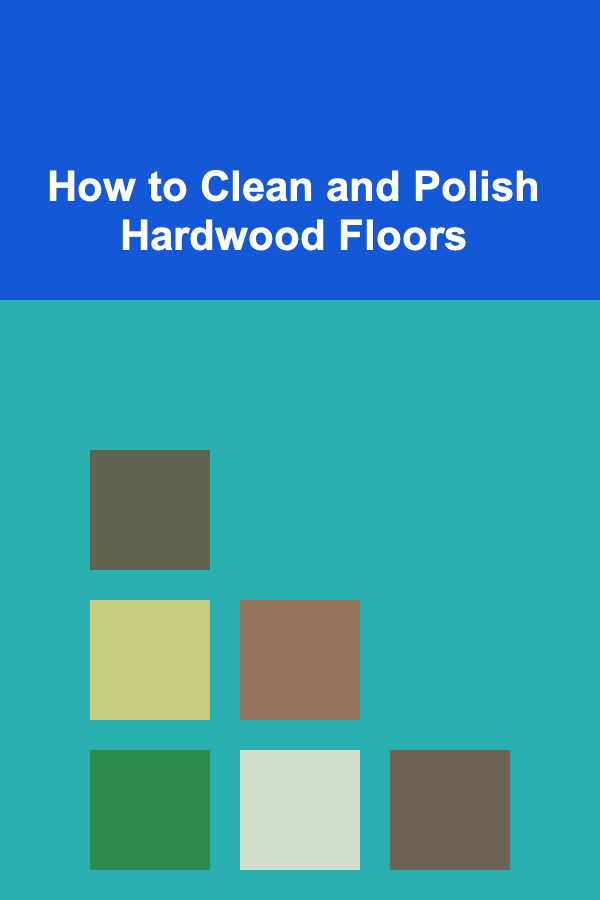
How to Clean and Polish Hardwood Floors
ebook include PDF & Audio bundle (Micro Guide)
$12.99$9.99
Limited Time Offer! Order within the next:

Hardwood floors are not only timeless in appearance but also a long-lasting investment for your home. They can last for generations if properly cared for. However, maintaining their beauty requires attention to both cleaning and polishing. Whether your hardwood floors are newly installed or years old, regular cleaning and polishing will help them retain their natural luster and beauty.
This article will guide you through the process of cleaning and polishing hardwood floors, covering everything from basic cleaning techniques to the finer details of polishing, and offering tips on maintaining their shine for the long haul.
Understanding Hardwood Floors
Before we dive into the specifics of cleaning and polishing, it's essential to understand the nature of hardwood floors. Hardwood floors are made from solid wood, usually oak, maple, cherry, or walnut, and are designed to last for decades. However, this durability depends heavily on proper care.
Wood is a porous material, and although it may be finished with protective coatings, it can still be vulnerable to dirt, dust, and moisture if not maintained properly. Understanding the finish on your hardwood floor---whether it's oil-based, water-based polyurethane, or wax---is important because different finishes require different cleaning and polishing methods.
Step-by-Step Guide to Cleaning Hardwood Floors
The first step in maintaining the beauty of your hardwood floors is to keep them clean. Regular cleaning prevents dirt and grime from scratching the surface and dulling the finish. Here's a detailed guide on how to clean hardwood floors effectively.
1. Sweep or Dust Mop Regularly
Dust and dirt are the primary culprits when it comes to damaging hardwood floors. Over time, these particles can grind into the surface, causing scratches and wear. To avoid this, make it a habit to sweep or dust mop your hardwood floors daily or at least a few times a week.
- Dust Mop: A dust mop with microfiber pads works best because it traps dust and dirt without pushing it around. Avoid traditional brooms with bristles, as they can push debris into the cracks of the wood.
- Sweeping: If you prefer sweeping, use a soft-bristled broom to avoid scratching the surface of your floor. Sweep carefully and pick up any larger pieces of debris by hand or using a vacuum cleaner.
2. Vacuum Your Floors
Vacuuming is another excellent way to remove dirt and debris from your hardwood floors. However, not all vacuum cleaners are suitable for hardwood floors. Avoid vacuums with a rotating brush or beater bar, as these can scratch the surface of the wood. Opt for a vacuum with a bare-floor setting or one that comes with a soft floor nozzle.
- Important Tip: Always vacuum with the grain of the wood to ensure a thorough clean and avoid scratching the floor.
3. Clean with a Damp Mop
Once the surface is free of dust and debris, it's time for a deeper clean. A damp mop is an effective way to clean the floors without introducing excessive moisture, which can damage wood.
- Choose the Right Mop: Use a microfiber mop because it holds moisture well and can trap dirt effectively. Avoid string mops, as they tend to hold too much water and may leave puddles that can seep into the wood.
- Mopping Solution: Use a cleaning solution designed for hardwood floors. You can either purchase a commercial product or make your own by mixing a few drops of mild dish soap with warm water. If your floor has a polyurethane finish, you can also use a solution of vinegar and water (1/4 cup of vinegar to 1 gallon of water).
Important Note: Always ensure the mop is damp, not soaking wet. Excess water can seep into the seams and cracks of the wood, leading to swelling or warping.
4. Dry the Floor Immediately
After mopping, dry the floor immediately with a clean, dry microfiber cloth or towel. Leaving the floor damp can cause water to seep into the wood, leading to discoloration, warping, or mold growth.
5. Clean Spills Immediately
Spills on hardwood floors should be cleaned immediately to prevent stains or damage. Use a soft cloth to blot the spill gently. Avoid scrubbing the spill, as it can damage the finish. For sticky substances, use a mild cleaning solution and then wipe it dry.
How to Polish Hardwood Floors
After cleaning, your hardwood floors may look clean but could lack the shine that makes them stand out. Polishing your hardwood floors restores their luster, smoothness, and shine. Polishing also provides an added layer of protection to the surface. However, polishing is not something that needs to be done as frequently as cleaning. It's generally recommended every 3-6 months, depending on foot traffic and wear.
1. Choose the Right Polish
Before you begin polishing, it's crucial to select the right type of polish for your hardwood floor. Not all polishes are created equal, and using the wrong one can lead to buildup or damage the finish.
- Water-based polish: This is a popular choice for floors with polyurethane finishes. It dries quickly and leaves a non-toxic, glossy finish.
- Oil-based polish: For floors with an oil finish, oil-based polish can restore the shine without causing a buildup.
- Wax-based polish: If your floor is finished with a wax coating, wax-based polish is the ideal choice. It adds a layer of protection while enhancing the natural beauty of the wood.
2. Apply the Polish Correctly
- Clean the floor thoroughly: Before applying any polish, ensure that the floor is clean and free of dust, dirt, and grime. Follow the steps mentioned above to prepare the floor.
- Test the product: Test the polish on a small, inconspicuous area of the floor to ensure it does not cause any discoloration or damage.
- Use a clean cloth or applicator: Apply the polish in small sections. Use a soft, clean cloth, mop, or applicator pad to spread the polish evenly over the floor, working with the grain of the wood.
- Work in sections: Do not apply the polish to the entire floor at once. Work in sections so you can maintain control and ensure an even coat.
3. Let the Polish Dry
Allow the polish to dry completely. This may take anywhere from 30 minutes to several hours, depending on the type of polish used. Ensure no one walks on the floor until the polish is fully dry to prevent any smudges or imprints.
4. Buff the Floor for Extra Shine
Once the polish has dried, use a soft cloth or a buffing machine to buff the floor gently. Buffing helps to smooth out any uneven areas and enhances the shine. It also ensures that the polish is properly bonded to the floor's surface.
Tips for Maintaining Hardwood Floors
In addition to regular cleaning and polishing, here are some essential maintenance tips that can help extend the life of your hardwood floors and keep them looking beautiful for years.
1. Use Rugs and Mats
Placing rugs and mats at entryways, in high-traffic areas, and in front of sinks can help protect your hardwood floors from dirt, moisture, and abrasion. Make sure to choose rugs with non-slip backs to prevent them from moving and causing tripping hazards.
2. Trim Pet Nails
If you have pets, keep their nails trimmed to prevent scratches and damage to the hardwood floor. Pet nails can easily cause deep scratches in the surface if left unchecked.
3. Keep Furniture Legs Protected
Furniture can leave dents and scratches on hardwood floors if not properly protected. Use felt pads or furniture coasters on the bottom of furniture legs to prevent them from scratching the floor when moved.
4. Avoid High Heels and Heavy Shoes
High heels and heavy shoes can cause dents and scratches on hardwood floors. Try to avoid wearing them indoors, or ensure that shoes are properly cleaned and free of debris before walking on hardwood floors.
5. Control Humidity Levels
Wood is a natural material, and it can expand and contract based on the humidity levels in the air. To prevent cracking, warping, or gapping, try to maintain a stable humidity level in your home. Consider using a humidifier during dry winter months or a dehumidifier during the summer.
Conclusion
Maintaining the beauty of your hardwood floors involves more than just occasional sweeping. Regular cleaning and polishing, combined with proper maintenance, will help your hardwood floors retain their stunning appearance and durability. By following the steps outlined in this guide, you can ensure that your floors remain shiny, smooth, and protected from damage. With the right care and attention, your hardwood floors can continue to be a timeless feature in your home for many years to come.

How to Create a Backup Plan for Unexpected Travel Changes
Read More
How to Prepare for Transitioning Back to In-Person Learning
Read More
How to Stage Your Home for Buyers Looking for a Green Lifestyle
Read More
Top Tips for Buying Pre-Owned Electronics Without the Risk
Read MoreHow to Use an Auto Insurance Expense Tracker for Tax Deductions
Read More
10 Tips for Hiking in the Rain: Gear & Techniques
Read MoreOther Products

How to Create a Backup Plan for Unexpected Travel Changes
Read More
How to Prepare for Transitioning Back to In-Person Learning
Read More
How to Stage Your Home for Buyers Looking for a Green Lifestyle
Read More
Top Tips for Buying Pre-Owned Electronics Without the Risk
Read MoreHow to Use an Auto Insurance Expense Tracker for Tax Deductions
Read More